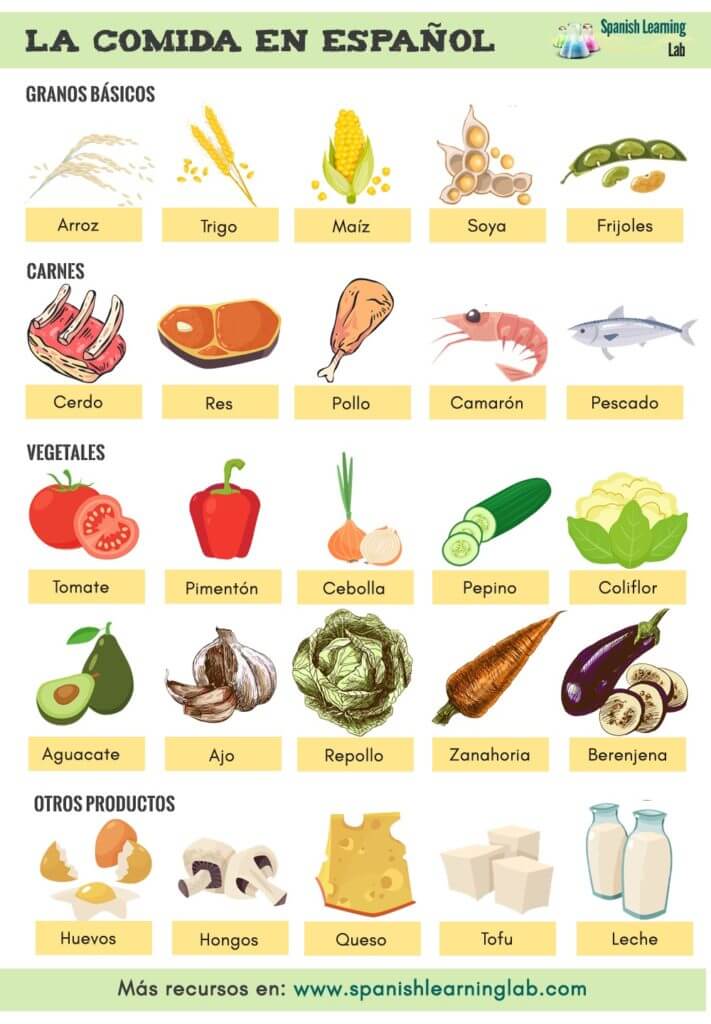Hello! Thank you very much for learning Spanish with us. On this occasion, we will learn the vocabulary for grains, meats, dairy products and others that are normally consumed in many countries around the world. We hope that the images, examples and exercises in the lesson help you to speak about food in Spanish without difficulties. Let’s start …
Vegetables, meats, dairy and other products in Spanish
First, let’s learn the vocabulary we need to talk about food in Spanish, starting with basic grains, fruits and vegetables, meats, and more. Pay attention to the picture and try to memorize the most important words in it. We will be using them later in sentences and a listening activity.

| Me gusta comer vegetales y algunos granos básicos. No me gusta la carne. I like to eat vegetables and some basic grains. I do not like meat. |
|
¿Te gusta comer arroz? – Claro que si, mi favorito es el arroz integral.
Do you like to eat rice? – Of course, my favorite is brown rice.
|
|
¿Qué comes en el desayuno normalmente? – Un huevo y una tortilla de maíz
What do you usually eat for breakfast? – An egg and a corn tortilla
|
|
¿Qué desayunaste hoy? – Desayuné aguacate con queso y frijoles fritos.
What did you have for breakfast today? – I ate avocado with cheese and fried beans for breakfast.
|
|
¡Qué rico! Estás comiendo pescado frito con arroz y ensalada.
Delicious! You are eating fried fish with rice and salad.
|
|
Me gustaría comerme una hamburguesa de res doble con papas fritas.
I’d like to eat a double beef burger with fries.
|
|
¿Qué prefieres, filete de pollo o filete de res? – Creo que comeré pollo mejor.
Which do you prefer, chicken fillet or beef fillet? – I think I’d better eat chicken.
|
|
Mesero, ¿Que lleva este platillo? – Lleva camarones, arroz, repollo, cebolla picada, pimentón y un poquito de ajo.
Waiter, what’s in this dish? – It has shrimp, rice, cabbage, chopped onion, bell peppers and a little garlic.
|
|
¿Tenemos queso en casa? – No, solo tenemos leche y mantequilla.
Do we have cheese at home? – No, we only have milk and butter.
|
| Tengo que ir al mercado a comprar berenjenas, una coliflor y soya para la dieta que me recomendó el doctor. I have to go to the market to buy eggplants, cauliflower and soy for the diet that the doctor recommended. |
Grammar: Ways to talk about likes and preferences in Spanish
As you can see in the previous sentences, there are several ways to talk about likes and preferences in Spanish:
- Direct object pronoun + GUSTAR + verb: The verb “gustar” is used accompanied by a pronoun such as “ME, NOS, TE”. The pronouns are placed before the verb “gustar” to indicate who likes something, eg: “Me gusta comer camarones” (I like to eat shrimp)
- Pronoun + GUSTARÍA: The structure “gustaría” corresponds to “would like” in English, as used in the example: “¿Te gustaría comer cerdo, res o pollo?” (Would you like to eat pork, beef or chicken?)
- Personal pronoun + PREFERIR / PREFERIRÍA: finally, we can use the verb prefer plus another verb to talk about what we like or prefer in this case, for example: “Yo prefiero comer aguacate con queso que huevo con tomate” (I prefer to eat avocado with cheese than egg with tomato)
Spanish Listening Activity: What are you cooking?
Related Spanish Worksheet:
- Fruits and Vegetables in Spanish – PDF Crossword Puzzle
- Food in Spanish: conversation cards – PDF worksheet
- At a Fast Food Restaurant in Spanish – PDF Worksheet
